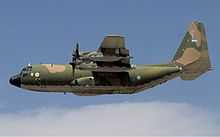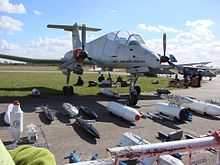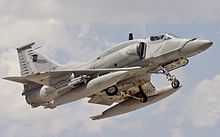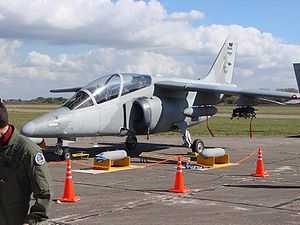Argentine Air Force
| Argentine Air Force Fuerza Aérea Argentina | |
|---|---|
|
The Argentine Air Force Emblem. | |
| Active | 1945–Present |
| Country | Argentina |
| Size |
14,600 personnel 163 aircraft[1] |
| March | Alas Argentinas (Argentine Wings) |
| Anniversaries |
August 10 (anniversary) May 1 (Baptism of fire during the Falklands War) |
| Battle honours |
Operativo Independencia (1975) Falkland Islands (1982) |
| Commanders | |
| Chief of Staff | Lieutenant-General Mario Miguel Callejo |
| Insignia | |
| Roundel |
 |
| Fin Flash |
 |
| Aircraft flown | |
| Attack | Pucará, A-4AR |
| Fighter | A-4AR |
| Interceptor | Mirage IIIEA |
| Trainer | T-34, Tucano, Pampa, Grob 120TP |
| Transport | C-130, Fokker F28, Fokker F27, DHC-6 |
The Argentine Air Force (Spanish: Fuerza Aérea Argentina, or simply FAA) is the national aviation branch of the Armed Forces of the Argentine Republic. In 2010 it had 14,600 military personnel and 6,900 civilian personnel.[2]
History
The Air Force's history begins with the establishment of the Army Aviation Service's Escuela de Aviación Militar (Military Aviation School) on 10 August 1912. Several military officers were amongst the pioneers of Argentine aviation, including Jorge Newbery, a retired Argentine Navy officer. The school began to turn out military pilots who participated in milestone events in Argentine aviation, such as the crossing of the Andes mountains.
Interwar period
In 1927 the Dirección General de Aeronáutica (General Directorate of Aeronautics) was created to coordinate the country's military aviation. In that same year the Fábrica Militar de Aviones (Military Aircraft Factory, FMA), which would become the heart of the country's aviation industry, was founded in Córdoba.

By 1938–39 the Argentine air force had about 3,200 staff (including about 200 officers), and maintained about 230 aircraft. About 150 of these were operated by the army and included Dewoitine D.27 and Curtiss P-36 Hawk fighters; Breguet 19, Fairey III and Stearman 76 D1 reconnaissance planes; Northrop A-17, North American NA-16, Martin B-10 heavy combat craft, Focke-Wulf Fw 58 as multi-role planes, and Lockheed Model 14 Super Electra, Junkers Ju 52, Douglas Dolphin, Curtiss T-32 Condor II and Fairchild 82 transporters. About 80 were operated by the navy and included the Supermarine Southampton, Supermarine Walrus, Fairey Seal, and Vought O2U Corsair variants, Consolidated P2Y, and Grumman J2F Duck.[3]
World War II and immediate post-war
By the 1940s there were several air units in the Army and the Navy; the first step towards an independent force came on 11 February 1944 with the establishment of the Aeronautical Command, which would go on to become the Argentine Air Force on 4 January 1945, an independent force on par with the Army and the Navy.

Immediately after the end of World War II, in which the Argentine Air Force took no part, it began a process of modernization, incorporating aircraft such as the Gloster Meteor jet fighter, thus becoming the first air force in Latin America equipped with jet-propelled aircraft. In addition, a number of Avro Lincoln and Avro Lancaster bombers were acquired, creating a powerful strategic force in the region. The Air Force, with former Luftwaffe technicians, also began to develop its own aircraft, such as the Pulqui I and Pulqui II, making Argentina the first country in Latin America and the sixth in the world to develop jet fighter technology on its own.
Antarctic support
In 1952 the Air Force began flights to supply the Antarctic scientific bases using ski-equipped C-47s[4] and established Marambio Base on 25 September 1969. On 11 April 1970[5] a C-130 Hercules, the TC-61 commanded by Commodore Arturo Athos Gandolfi, was the first airplane to land in Marambio;[6] the Fokker F-28 Fellowship presidential aircraft T-01 Patagonia is reportedly the first jet to have landed at Marambio, on 28 July 1973;[7][8] and since the 1970s Twin Otters are also deployed.[9] On October 1973 the FAA launched Operation Transantar, achieving the first trans-Antarctic three-continental flight in history when a C-130 flew between Rio Gallegos; Marambio, Argentine Antarctica; Christchurch, New Zealand and Canberra, Australia.[10][11]
Modernization and The Falklands War
During the 1970s the Air Force re-equipped itself with modern aircraft, including Mirage III interceptors, IAI Dagger multi-role fighters (Israeli derivatives of the Mirage V), A-4 Skyhawk attack aircraft and C-130 Hercules cargo planes. A counter-insurgency airplane, the Pucará, was also used in substantial numbers.
The Falklands War (Spanish: Guerra de las Malvinas/Conflicto del Atlántico Sur), took a great toll on the Air Force, which lost 60 aircraft. After the war, due to the deteriorating economic situation, international opposition and political distrust of the military, the Air Force was denied the resources needed to replace the war losses. This, coupled with diminishing budgets, led to a period of reduced activity and growing materiel obsolescence.

After the war Britain imposed an arms embargo on Argentina, which was discontinued in the 1990s. After attempts to acquire surplus IAI Kfirs or F-16As failed for economic and political reasons, the United States military sold Argentina 36 A-4AR Fightinghawks, a refurbished and upgraded version of the A-4 Skyhawks used in the war.
Support to UN peacekeeping missions
The FAA has been involved in United Nations peacekeeping missions around the world. They sent a Boeing 707 to the 1991 Gulf War. Since 1994 the UN Air contingent (UNFLIGHT) in Cyprus under UNFICYP mandate is provided by the FAA,[12] having achieved 10,000 flight hours by 2003 without any accidents.[13] The FAA has also since 2005 deployed Bell 212 helicopters to Haiti under MINUSTAH mandate.
In the 21st century
In early 2005 the top seventeen brigadiers of the Air Force, including the Chief of Staff, Brigadier General Carlos Rohde, were sacked by President Néstor Kirchner following a scandal involving drug trafficking through Ezeiza International Airport. Kirchner cited failures in the security systems of Argentine airports (which were overseen by the National Aeronautic Police, a branch of the Air Force) and cover-ups of the scandal; it later became known that many government agencies, among them the Interior Ministry, the Customs Administration and the Secretariat of State Intelligence knew about the drug trafficking.
The primary concerns of the Air Force as of 2010 are the establishment of a radar network for control of the country's airspace, the replacement of its older combat aircraft (Mirage III, Mirage V) and the incorporation of new technologies. The possibility of purchasing surplus French Air Force Mirage 2000C fighters, like the option chosen by the Brazilian Air Force, has been considered.
Since the 1990s the FAA has established good relations with its neighbours, the Brazilian and Chilean Air Forces. They annually meet, on a rotation basis, in the joint exercises Cruzex in Brazil, Ceibo in Argentina and Salitre in Chile.

In 2007 an FAA FMA IA 58 Pucará was converted to use a modified engine operating on soy-derived bio-jet fuel. The project, financed and directed by the Argentine Government (Secretaría de Ciencia Tecnología e Innovación Productiva de la Nación), made Argentina the second nation in the world to propel an aircraft with biojet fuel. The purpose of the project is to make the FAA less reliant on fossil fuels.
As of 2010 budgetary constraints continued, leading to the disbanding of the Boeing 707 transport squadron and maintenance problems for half of the C-130 Hercules fleet. This was particularly evident when, in a matter of days in March, the same C-130 aircraft could be seen, in addition to their routine missions, traveling 3 to times to Haiti, 9 times to Chile (in both cases delivering humanitarian aid) and also doing a resupply airdrop to the Argentine southernmost Antarctic base Belgrano II.
In August 2010 a contract was signed for two Mi-17E helicopters, plus an option on a further three, to support Antarctic bases[14][15] although no official destination form them have been release yet and is possible that they will be assigned to the Argentine Army Aviation.
The FAA is seeking to replace its ageing force with a more capable and more serviceable modern aircraft. The acquisition of Spanish Mirage F1Ms, IAI Kfir Block 60s and Saab Gripen E/Fs was considered, but as of February 2015, all of those deals appear to have stalled; The Mirage F1 deal was scrapped by the Spanish government in March 2014 after pressure of the UK to not assist in FAA modernization over tensions between the countries over the Falkland Islands.[16] The UK has also managed to veto the sale of Gripen E/Fs, as 30% of the Gripen's parts are manufactured there. The deal with Israel has reportedly stalled for technical and political reasons. China has reportedly offered JF-17/FC-1 or Chengdu J-10 to Argentina. The two countries have formed a working group to look into the transfer of 14 aircraft.[17][18] Russia had also offered to lease 12 Su-24 strike aircraft to the FAA, but Jane's reported that the Su-24 wouldn't be very useful to the FAA and that "it would appear that any proposed transfer of such aircraft is likely the result of Russia playing political games with the UK over the continuing crisis in Ukraine.".[19]
Organization
The Argentine Air Force is one of the three branches of the Argentine military, having equal status with the Army and the Navy. The President of Argentina is Commander-in-Chief of all three services.
The Air Force is headed by the Chief of the General Staff (Jefe del Estado Mayor General), directly appointed and removed by the President. The Air Force Chief of Staff usually holds the rank of Brigadier General, the highest rank of the Air Force. The Chief of Staff is seconded by a Deputy Chief of the General Staff and three senior officers in charge of the Air Force's three Commands: the Air Operations Command, the Personnel Command and the Materiel Command.
The Air Operations Command (Comando de Operaciones Aéreas) is the branch of the Air Force responsible for aerospace defense, air operations, planning, training, technical and logistical support of the air units. Subordinate to the Air Operations Command are the Air Brigades (Brigadas Aéreas), the Air Force's major operative units. A total of eight Air Brigades are currently operational. Brigades are headquartered at Military Air Bases (Base Aérea Militar (BAMs).
Each Air Brigade is made up of three Groups, each bearing the same number as their mother Brigade. These groups include:
- One Air Group (Grupo Aéreo), which operates the aircraft assigned to the Brigade. The Air Group is divided into a variable number of Air Squadrons. Air Groups may be named according to their primary mission, for example an air group specialized in fighter operations receives the designation of Fighter Group (Grupo de Caza). Currently the Air Force includes three Fighter Groups (4th, 5th and 6th), one Attack Group (3rd), one Transport Group (1st) and three plain Air Groups (2nd, 7th and 9th). The 7th Air Group operates all the helicopters of the Air Force, while the 2nd includes a small reconnaissance unit as well as light transport aircraft. 9th Air Group is a light transport unit.
- One Technical Group (Grupo Técnico), in charge of the maintenance and repair of the Brigade's aircraft.
- One Base Group (Grupo Base), responsible for the air base itself, weather forecasting, flight control, runway maintenance, etc. Base Groups also include Base Flights (Escuadrillas de Base), generally made up of two or three liaison aircraft.
The Personnel Command (Comando de Personal) is responsible for the training, education, assignment and welfare of Air Force personnel. Under the control of the Personnel Command are the Military Aviation School (which educates the future officers of the Air Force), the Air Force Non-Commissioned Officer (NCO) School and other educational and training units.
The Materiel Command (Comando de Material) deals with planning and executing the Air Force's logistics regarding flying and ground materiel. Materiel Command includes "Quilmes" and "Río Cuarto" Materiel Areas (repairing and maintenance units) and "El Palomar" Logistical Area.
Order of battle




- 1st Air Brigade (El Palomar Military Air Base, Buenos Aires Province) in El Palomar Airport
- 1st Air Transport Squadron (C-130 Hercules)
- 2nd Air Transport Squadron (Fokker F-28)
- 2nd Air Brigade (Paraná Military Air Base, Entre Ríos Province) in General Justo José de Urquiza Airport
- 2nd Reconnaissance Squadron (Learjet 35A)
- 4th Air Transport Squadron (Fokker F-27)
- 3rd Air Brigade (Reconquista Military Air Base, Santa Fe Province) in Daniel Jukic Airport
- 2nd Attack Squadron (IA-58A Pucara)
- 3rd Attack Squadron (IA-58A Pucara)
- 4th Air Brigade (El Plumerillo Military Air Base, Mendoza Province) in Governor Francisco Gabrielli International Airport
- 1st Training Squadron (FMA IA 63 Pampa serie 2)
- 3rd Search and Rescue Squadron (SA-315B Lama)
- 4th Cruz del Sur Aerobatics Squadron (Su-29)
- Fighter School
- 5th Air Brigade (Villa Reynolds Military Air Base, San Luis Province) in Villa Reynolds Airport
- 1st Fighter-Bomber Squadron (A-4AR Fightinghawk)
- 2nd Fighter-Bomber Squadron (A-4AR Fightinghawk)
- 6th Air Brigade (Tandil Military Air Base, Buenos Aires Province, Mirage IIIEA/DA, Mirage 5PA, IAI Finger) in Tandil Airport
- 1st Fighter-Bomber Squadron (AMD Mirage 5P Mara)
- 2nd Fighter-Bomber Squadron (IAI Finger)
- 3rd Air Interceptor Squadron (AMD Mirage IIIEA/DA)
- 7th Air Brigade (Moreno Military Air Base, Buenos Aires Province) in Mariano Moreno Airport
- 1st Search and Rescue Squadron (Bell 212)
- 2nd Tactical Squadron (Hughes 500D)
- 3rd Squadron (UH-1H)
- 4th Squadron (UH-1H, Hughes 500E)
- 9th Air Brigade (Comodoro Rivadavia Military Air Base, Chubut Province) in General Enrique Mosconi International Airport
- 6th Air Transport Squadron (SAAB 340B)
- 7th Air Transport Squadron (DHC-6 Twin Otter)
- Military Aviation School (Cordoba, Córdoba Province)
- Glider Flight
- Services Squadron
- Mentor Squadron (Grob G 120TP)
- Tucano Squadron (Embraer EMB-312 Tucano)
- Special Operations Group (Spanish: Grupo de Operaciones Especiales, GOE)
- Agrupación Aérea Presidencial, Presidential transportation Unit
Ranks
Officers
Officers wear their rank insignia in their sleeves, in the pattern depicted below. There are also shoulderboards with the same insignia (albeit in gray) for the ranks between Ensign and Commodore. General officers wear different shoulder boards.
| Insignia | Equivalent NATO Rank Code | Rank in Spanish | Rank in English | Commonwealth equivalent | US Air Force equivalent |
|---|---|---|---|---|---|
 |
OF-9 | Brigadier General | Brigadier General | Air Chief Marshal | General |
 |
OF-8 | Brigadier Mayor | Brigadier-Major | Air Marshal | Lieutenant General |
 |
OF-7 | Brigadier | Brigadier | Air Vice-Marshal | Major General |
| OF-6 (honorary rank) | Comodoro Mayor | Commodore Major (honorary rank given to Commodores) |
Air Commodore | Brigadier General | |
 |
OF-5 | Comodoro | Commodore | Group Captain | Colonel |
 |
OF-4 | Vicecomodoro | Vice-Commodore | Wing Commander | Lieutenant Colonel |
 |
OF-3 | Mayor | Major | Squadron Leader | Major |
 |
OF-2 | Capitán | Captain | Flight Lieutenant | Captain |
 |
OF-1 | Primer Teniente | First Lieutenant | Flying Officer | First Lieutenant |
 |
OF-1 | Teniente | Lieutenant | Pilot Officer | Second Lieutenant |
 |
OF-D | Alférez | Ensign | Acting Pilot Officer |
Non-Commissioned Officers and Enlisted personnel
| Insignia | Rank in Spanish | Rank in English | US Air Force equivalent | RAF equivalent |
|---|---|---|---|---|
 |
Suboficial Mayor | Sub-Officer Major | Chief Master Sergeant, Command Chief Master Sergeant |
Warrant Officer |
 |
Suboficial Principal | Principal Sub-Officer | Senior Master Sergeant | Chief Technician |
| |
Suboficial Ayudante | Staff Sub-Officer or Adjutant Sub-Officer | Master Sergeant | Flight Sergeant |
| |
Suboficial Auxiliar | Auxiliary Sub-Officer | Technical Sergeant | Sergeant |
 |
Cabo Principal | Principal Corporal | Staff Sergeant | Corporal |
 |
Cabo Primero | Corporal First Class | Senior Airman | Junior Technician |
 |
Cabo | Corporal | Airman First Class | Senior Aircraftman/Senior Aircraftwoman |
| |
Voluntario Primero | Volunteer First Class | Airman | Leading Aircraftman/Leading Aircraftwoman |
| |
Voluntario Segundo | Volunteer Second Class | Airman Basic | Aircraftman/Aircraftwoman |
Aircraft
Current inventory
.jpg)
.jpg)



Chiefs of the Argentine Air Force
See also
| Wikimedia Commons has media related to Air force of Argentina. |
- Argentine Military - other air services
- Argentine Army
- Argentine Navy
- Military of Argentina
- Operational use
- Units and related organisations
- Agrupación Aérea Presidencial – Presidential VIP fleet
- Argentine Air Force Mobile Field Hospital
- LADE – State government airline
Bibliography
- International Institute for Strategic Studies; Hackett, James (ed.) (2010-02-03). The Military Balance 2010. London: Routledge. ISBN 1-85743-557-5.
References
- ↑ World Air Force 2014 - Flight International, Flightglobal.com, Accessed 23 November 2014
- ↑ IISS 2010, pp. 64–67
- ↑ Schnitzler, R.; Feuchter, G.W.; Schulz, R., eds. (1939). Handbuch der Luftwaffe [Aviation Manual] (in German) (3rd ed.). Munich and Berlin: J. F. Lehmanns Verlag. p. 13.
- ↑ "Douglas DC-3 & C-47 en la Fuerza Aérea Argentina - Avialatina". YouTube. Retrieved 24 December 2014.
- ↑ "Primer aterrizaje de un Hércules C-130 en Marambio". Retrieved 24 December 2014.
- ↑ Gustavo Lepez. "TODA LA AVIACION - MALVINAS ARGENTINAS -". Retrieved 24 December 2014.
- ↑ Marambio Station on the webpage of the French Polar Teams.
- ↑ "Aniversario Aereo de la Antartida Argentina". Retrieved 24 December 2014.
- ↑ Twin Otter picture
- ↑ "The First Three-Continental and Transantarctic Flight". Fin del Mundo. Sitio Oficial de la Provincia de Tierra del Fuego, Antártida e Islas del Atlántico Sur. Archived from the original on 1 October 2013.
- ↑ "Primer Vuelo Transantártico Tricontinental. Operación "Transantar" (04 al 10-Oct-1973)" (in Spanish). Fundación Marambio. Archived from the original on 28 February 2009.
- ↑ "- Fuerza Area Argentina". Retrieved 24 December 2014.
- ↑ "VII Brigada Aerea". Retrieved 24 December 2014.
- ↑ Argentina formaliza la compra de cinco MI-17
- ↑ "Iniciativa para reequipar a las FF.AA.". Retrieved 24 December 2014.
- ↑ Argentina; Spanish Mirage F-1 deal scrapped due to UK preassure - Dmilt.com, 7 March 2014
- ↑ "Argentina's Jet Fighter Replacement Options Narrow". Defensenews.com. 30 November 2014. Retrieved 18 February 2015.
- ↑ "Argentina seeks Kfir deal with Israel" January 13, 2014
- ↑ "Argentina and China agree fighter aircraft working group". IHS Jane's 360. 5 February 2015. Retrieved 18 February 2015.
- ↑ 20.0 20.1 20.2 20.3 20.4 20.5 20.6 20.7 20.8 20.9 20.10 20.11 20.12 20.13 20.14 20.15 20.16 20.17 20.18 20.19 20.20 20.21 20.22 20.23 20.24 "World Air Forces 2015 pg. 10". Flightglobal Insight. 2015. Retrieved 18 December 2014.
- ↑ "Presidencia Introducción". aeromilitaria.com.ar. Retrieved 22 December 2014.
- ↑ "Fuerza Aerea Argentina T-04". airfleets.net. Retrieved 28 December 2014.
- ↑ "World Air Forces 2004". Flightglobal Insight. 2004. Retrieved 17 January 2014.
- ↑ "Fuerza Aerea Argentina VIP S-76". Retrieved 1 January 2015.
- ↑ "Fuerza Aerea Argentina Bell 412". Retrieved 22 December 2014.
External links
- Official website (Spanish)
- Organization and equipment (English)
